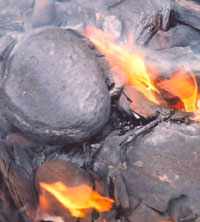Related Research Articles

Oil shale is an organic-rich fine-grained sedimentary rock containing kerogen from which liquid hydrocarbons can be produced. In addition to kerogen, general composition of oil shales constitutes inorganic substance and bitumens. Based on their deposition environment, oil shales are classified as marine, lacustrine and terrestrial oil shales. Oil shales differ from oil-bearing shales, shale deposits that contain petroleum that is sometimes produced from drilled wells. Examples of oil-bearing shales are the Bakken Formation, Pierre Shale, Niobrara Formation, and Eagle Ford Formation. Accordingly, shale oil produced from oil shale should not be confused with tight oil, which is also frequently called shale oil.

Pumpherston is a village in West Lothian, Scotland. Originally a small industrial village housing works for the nearby shale mine and works, it now forms the eastern part of the new town of Livingston, which was constructed to the west of Pumpherston in the late 1960s and quickly grew to incorporate Pumpherston in its wider urban settlement, as defined by the General Register Office for Scotland (GROS). The village of Uphall Station lies immediately to the north. It is twinned with the village of Mtarfa, Malta.
Shale oil is an unconventional oil produced from oil shale rock fragments by pyrolysis, hydrogenation, or thermal dissolution. These processes convert the organic matter within the rock (kerogen) into synthetic oil and gas. The resulting oil can be used immediately as a fuel or upgraded to meet refinery feedstock specifications by adding hydrogen and removing impurities such as sulfur and nitrogen. The refined products can be used for the same purposes as those derived from crude oil.

Newnes, an abandoned oil shale mining site of the Wolgan Valley, is located in the Central Tablelands region of New South Wales, Australia. The site that was operational in the early 20th century is now partly surrounded by Wollemi National Park. The settlement was originally built by the Commonwealth Oil Corporation.

Glen Davis is a village in the Central Tablelands of New South Wales, Australia. The village is located in the local government area of the City of Lithgow. It is located 250 km north-west of Sydney and approximately 80 kilometres north of Lithgow. The name is also applied to the surrounding area, for postal and statistical purposes. In the 2006 census, Glen Davis had a population of 354 but this fell to 115 in the 2016 census.

Shale oil extraction is an industrial process for unconventional oil production. This process converts kerogen in oil shale into shale oil by pyrolysis, hydrogenation, or thermal dissolution. The resultant shale oil is used as fuel oil or upgraded to meet refinery feedstock specifications by adding hydrogen and removing sulfur and nitrogen impurities.
Oil shale economics deals with the economic feasibility of oil shale extraction and processing. Although usually oil shale economics is understood as shale oil extraction economics, the wider approach evaluates usage of oil shale as a whole, including for the oil-shale-fired power generation and production of by-products during retorting or shale oil upgrading processes.

The history of the oil shale industry started in ancient times. The modern industrial use of oil shale for oil extraction dates to the mid-19th century and started growing just before World War I because of the mass production of automobiles and trucks and the supposed shortage of gasoline for transportation needs. Between the World Wars oil shale projects were begun in several countries.
Oil shale in China is an important source of unconventional oil. A total Chinese oil shale resource amounts of 720 billion tonnes, located in 80 deposits of 47 oil shale basins. This is equal to 48 billion tonnes of shale oil. At the same time there are speculations that the actual resource may even exceed the oil shale resource of the United States.
Alexander François Selligue (1784-1845) was a French engineer. His name was in fact Alexandre François Gilles, but he used Selligue as an anagram of Gilles.
The Nevada–Texas–Utah retort process was an above-ground shale oil extraction technology to produce shale oil, a type of synthetic crude oil. It heated oil shale in a sealed vessel (retort) causing its decomposition into shale oil, oil shale gas and spent residue. The process was developed in the 1920s and used for shale oil production in the United States and in Australia. The process was simple to operate; however, it was ceased from the operation because of a small capacity and labor extensiveness.

Alexander Carnegie Kirk was a British engineer responsible for several major innovations in the shipbuilding, refrigeration, and oil shale industries of the 19th century. Kirk, born in Barry, Angus, received his formal education at the University of Edinburgh and a technical education at plants operated by Robert Napier and Sons.
There are oil shale deposits in Australia which range from small deposits to large reserves. Deposits, varying by their age and origin, are located in about a third of eastern Australia. In 2012, the demonstrated oil shale reserves were estimated at 58 billion tonnes. The easiest to recover deposits are located in Queensland.

The Glen Davis Shale Oil Works was a shale oil extraction plant, in the Capertee Valley, at Glen Davis, New South Wales, Australia, which operated from 1940 until 1952. It was the last oil-shale operation in Australia, until the Stuart Oil Shale Project in the late 1990s. For the period of 1965–1952, it provided one fifth of the shale oil produced in Australia.
The history of the oil shale industry in the United States goes back to the 1850s; it dates back farther as a major enterprise than the petroleum industry. But although the United States contains the world's largest known resource of oil shale, the US has not been a significant producer of shale oil since 1861. There were three major past attempts to establish an American oil shale industry: the 1850s; in the years during and after World War I; and in the 1970s and early 1980s. Each time, the oil shale industry failed because of competition from cheaper petroleum.
Commonwealth Oil Corporation Limited was a British-owned Australian company associated with the production and refining of petroleum products derived from oil shale, during the early years of the 20th century. It is associated with Newnes, Hartley Vale, and Torbane, all in New South Wales. It should not be confused with Commonwealth Oil Refineries, which was a completely separate company, established in 1920, that refined imported crude oil from 1924.
Torbane was a privately-owned village lying within the area now known as Capertee, in the Local Government Area of the City of Lithgow, within the Central West region of New South Wales, Australia. There was also another village, Airly, nearby. Both villages were associated with the mining of oil shale. The mine associated with Torbane was known as the New Hartley Mine. and that associated with Airly was known as the Genowlan Mine. There were retorts that produced crude shale oil at Torbane. Both Torbane and Airly are now ghost towns.

Sir George Francis Davis was a New Zealand born industrialist. He is notable mainly for his association with Davis Gelatine, Cockatoo Island Dockyard, and the Glen Davis Shale Oil Works, in Australia. Glen Davis, New South Wales is named after him.

John Wilson Fell (1862–1955) was an industrialist involved in the shale oil operations at Newnes, New South Wales and the establishment of two early oil refineries, on Gore Bay at Greenwich and at Clyde, both suburbs of Sydney. He was the principal of John Fell & Company and was, for many years, the Managing Director of Commonwealth Oil Corporation, which he revived from receivership.
The New South Wales Shale and Oil Company — established in 1872, by the merging of two earlier ventures — mined and processed oil shale to produce kerosene, paraffin wax and candles, and other petroleum products, in New South Wales Australia. It is particularly associated with the sites of its former works, at Hartley Vale and Torbane. Its assets were bought by Commonwealth Oil Corporation in 1906.
References
- 1 2 3 4 Louw, S.J.; Addison, J. (1985). Seaton, A. (ed.). "Studies of the Scottish oil shale industry. Vol.1 History of the industry, working conditions, and mineralogy of Scottish and Green River formation shales. Final report on US Department of Energy" (PDF). Institute of Occupational Medicine. pp. 38, 53–56. DE-ACO2 – 82ER60036. Archived from the original (PDF) on 26 July 2011. Retrieved 28 November 2009.
- ↑ Talbot, Frederick Arthur (2007). The Oil Conquest of the World. READ BOOKS. pp. 182–193. ISBN 978-1-4086-1045-9 . Retrieved 28 November 2009.
- ↑ United States Office of Technology Assessment (June 1980). An Assessment of Oil Shale Technologies (PDF). DIANE Publishing. p. 138. ISBN 978-1-4289-2463-5. NTIS order #PB80-210115. Retrieved 28 November 2009.
- 1 2 "Shale Processing". Sydney Morning Herald. 12 January 1951. p. 2. Retrieved 26 April 2022.
- ↑ "Ghost Towns: Newnes". visitsydneyaustralia.com.au. Retrieved 4 April 2022.
- ↑ "Newnes Oil Shale - Wollemi National Park". www.geomaps.com.au. Retrieved 4 April 2022.
- ↑ "Newnes Retorts". Sun. 3 July 1932. p. 9. Retrieved 4 April 2022.
- ↑ "TO WORK AGAIN". Sydney Morning Herald. 16 December 1914. p. 10. Retrieved 13 April 2022.
- ↑ Mainwaring, Ross (July 1993). "Glen Davis Oil Shale Works" (PDF). Light Railways. The Light Railway Research Society of Australia. XXX (121).
- 1 2 Alderson, Victor Clifton (2009). The Oil Shale Industry. BiblioBazaar. p. 68. ISBN 978-1-103-27580-9 . Retrieved 28 November 2009.
- ↑ Hull, Thomas (2009). Oils, Fats and Fuels. READ BOOKS. p. 61. ISBN 978-1-4067-4163-6 . Retrieved 28 November 2009.